BosnMate
Gold Member
- Sep 10, 2010
- 6,916
- 8,441
- Detector(s) used
- Whites MXT, Whites DFX, Whites 6000 Di Pro
- Primary Interest:
- Other
The next thing I'm going to try edit this post and take out the directions the cave at the head of Dog Creek in the Umpqua National Forest, which the Forest Service has removed from all their maps. I've recieved private messages asking me to take out the directions for fear the paintings might be vandalized. Personally I felt that the place is so darn remote that there would be little danger of that, but on the other hand, if someone did vandalize the site and it was my fault, I'd feel terrible, so on their advice I'll remove the directions. The location of the cave is in an area that is mineralized,
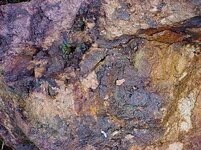 (this is peacock ore from the area) The head of the creek is a large basin with a mine on one ridge and the Indian cave on the other. The mine is a patented gold mine from around 1937, and I've been told that it's owned by a Canadian Company, so it's private property, but nobody stops someone if they want to visit it and poke around. The gold was low grade or, and nothing has been done there for years. It's quite a hike to get in there, but when there it's interesting.
(this is peacock ore from the area) The head of the creek is a large basin with a mine on one ridge and the Indian cave on the other. The mine is a patented gold mine from around 1937, and I've been told that it's owned by a Canadian Company, so it's private property, but nobody stops someone if they want to visit it and poke around. The gold was low grade or, and nothing has been done there for years. It's quite a hike to get in there, but when there it's interesting.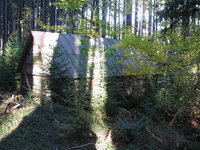
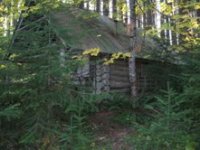 I can't make it anymore, the trail is on the ridge, and for a kid it isn't bad, but once off the ridge, trust me, the country stands on end.
I can't make it anymore, the trail is on the ridge, and for a kid it isn't bad, but once off the ridge, trust me, the country stands on end. 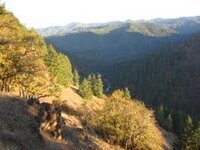 Beyond the mine you are entering an archeology sensitive area, and the Forest Service has a locked gate that in the past was only open during hunting season. The road is no longer maintained. In the area is Limpy Rock which has a cave at the base that is large enough to stable a dozen horses, and was occupied by the Indians. There are no paintings in this cave, and it is a booger to get to. The cave is at the down hill bottom of the rock, and the ground is hand hold steep getting down to it. The last three guys I took up there refused to go down to it. There was no evidence of artifacts, they have been picked over for years, but in the drip line of the cave there was lots of bones, remains of what they ate, and I was surprised at the small size of the animals, like they were mostly calf elk or deer fawns. I can recognize the remains of cloven hoofed animals, so they weren't dog bones. Not only is there the cave in the rock, there is also a vein of low grade peacock copper ore runs right through it, which I thought was interesting. I'd wondered where the Indians got their water the first time I was there, because it looked to me like they would have to go a long way. But with the google earth map it's easy to see a large spring a few hundred yards from the cave. At the dead end of the road, there is a trail to the Indian cave with paintings. This hike is on the ridge, and isn't too bad if you are young. It's all down hill going in, but it's all up hill coming out, and with my heart problems it was a long slow hike for me, and I won't be going again. Enough talking, here's the cave.
Beyond the mine you are entering an archeology sensitive area, and the Forest Service has a locked gate that in the past was only open during hunting season. The road is no longer maintained. In the area is Limpy Rock which has a cave at the base that is large enough to stable a dozen horses, and was occupied by the Indians. There are no paintings in this cave, and it is a booger to get to. The cave is at the down hill bottom of the rock, and the ground is hand hold steep getting down to it. The last three guys I took up there refused to go down to it. There was no evidence of artifacts, they have been picked over for years, but in the drip line of the cave there was lots of bones, remains of what they ate, and I was surprised at the small size of the animals, like they were mostly calf elk or deer fawns. I can recognize the remains of cloven hoofed animals, so they weren't dog bones. Not only is there the cave in the rock, there is also a vein of low grade peacock copper ore runs right through it, which I thought was interesting. I'd wondered where the Indians got their water the first time I was there, because it looked to me like they would have to go a long way. But with the google earth map it's easy to see a large spring a few hundred yards from the cave. At the dead end of the road, there is a trail to the Indian cave with paintings. This hike is on the ridge, and isn't too bad if you are young. It's all down hill going in, but it's all up hill coming out, and with my heart problems it was a long slow hike for me, and I won't be going again. Enough talking, here's the cave.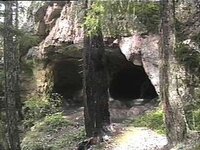
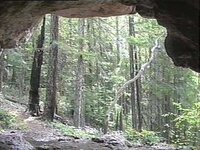
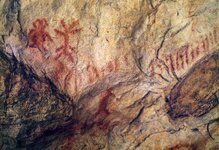
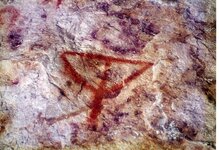
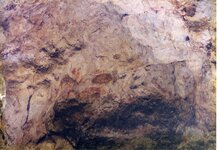
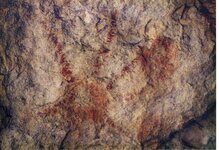
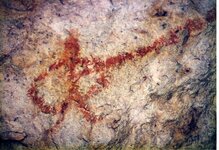
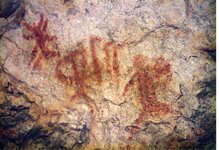
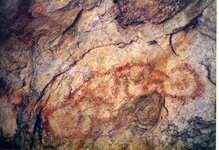
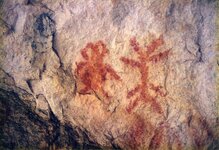
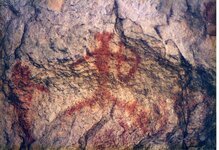
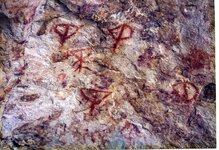
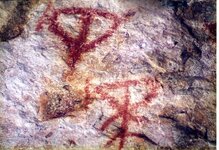 This cave was completely dug out at least 70 years ago, so there are no arrowheads to find, but that's not important anyhow, the paints are the best I've seen for a long time, these pictures were taken probably 30 years ago, and I was there last summer, the paintings seem to be faded, but there has been no vandalism, probably because it's really hard to get to.
This cave was completely dug out at least 70 years ago, so there are no arrowheads to find, but that's not important anyhow, the paints are the best I've seen for a long time, these pictures were taken probably 30 years ago, and I was there last summer, the paintings seem to be faded, but there has been no vandalism, probably because it's really hard to get to.
 (this is peacock ore from the area) The head of the creek is a large basin with a mine on one ridge and the Indian cave on the other. The mine is a patented gold mine from around 1937, and I've been told that it's owned by a Canadian Company, so it's private property, but nobody stops someone if they want to visit it and poke around. The gold was low grade or, and nothing has been done there for years. It's quite a hike to get in there, but when there it's interesting.
(this is peacock ore from the area) The head of the creek is a large basin with a mine on one ridge and the Indian cave on the other. The mine is a patented gold mine from around 1937, and I've been told that it's owned by a Canadian Company, so it's private property, but nobody stops someone if they want to visit it and poke around. The gold was low grade or, and nothing has been done there for years. It's quite a hike to get in there, but when there it's interesting.
 I can't make it anymore, the trail is on the ridge, and for a kid it isn't bad, but once off the ridge, trust me, the country stands on end.
I can't make it anymore, the trail is on the ridge, and for a kid it isn't bad, but once off the ridge, trust me, the country stands on end.  Beyond the mine you are entering an archeology sensitive area, and the Forest Service has a locked gate that in the past was only open during hunting season. The road is no longer maintained. In the area is Limpy Rock which has a cave at the base that is large enough to stable a dozen horses, and was occupied by the Indians. There are no paintings in this cave, and it is a booger to get to. The cave is at the down hill bottom of the rock, and the ground is hand hold steep getting down to it. The last three guys I took up there refused to go down to it. There was no evidence of artifacts, they have been picked over for years, but in the drip line of the cave there was lots of bones, remains of what they ate, and I was surprised at the small size of the animals, like they were mostly calf elk or deer fawns. I can recognize the remains of cloven hoofed animals, so they weren't dog bones. Not only is there the cave in the rock, there is also a vein of low grade peacock copper ore runs right through it, which I thought was interesting. I'd wondered where the Indians got their water the first time I was there, because it looked to me like they would have to go a long way. But with the google earth map it's easy to see a large spring a few hundred yards from the cave. At the dead end of the road, there is a trail to the Indian cave with paintings. This hike is on the ridge, and isn't too bad if you are young. It's all down hill going in, but it's all up hill coming out, and with my heart problems it was a long slow hike for me, and I won't be going again. Enough talking, here's the cave.
Beyond the mine you are entering an archeology sensitive area, and the Forest Service has a locked gate that in the past was only open during hunting season. The road is no longer maintained. In the area is Limpy Rock which has a cave at the base that is large enough to stable a dozen horses, and was occupied by the Indians. There are no paintings in this cave, and it is a booger to get to. The cave is at the down hill bottom of the rock, and the ground is hand hold steep getting down to it. The last three guys I took up there refused to go down to it. There was no evidence of artifacts, they have been picked over for years, but in the drip line of the cave there was lots of bones, remains of what they ate, and I was surprised at the small size of the animals, like they were mostly calf elk or deer fawns. I can recognize the remains of cloven hoofed animals, so they weren't dog bones. Not only is there the cave in the rock, there is also a vein of low grade peacock copper ore runs right through it, which I thought was interesting. I'd wondered where the Indians got their water the first time I was there, because it looked to me like they would have to go a long way. But with the google earth map it's easy to see a large spring a few hundred yards from the cave. At the dead end of the road, there is a trail to the Indian cave with paintings. This hike is on the ridge, and isn't too bad if you are young. It's all down hill going in, but it's all up hill coming out, and with my heart problems it was a long slow hike for me, and I won't be going again. Enough talking, here's the cave.











 This cave was completely dug out at least 70 years ago, so there are no arrowheads to find, but that's not important anyhow, the paints are the best I've seen for a long time, these pictures were taken probably 30 years ago, and I was there last summer, the paintings seem to be faded, but there has been no vandalism, probably because it's really hard to get to.
This cave was completely dug out at least 70 years ago, so there are no arrowheads to find, but that's not important anyhow, the paints are the best I've seen for a long time, these pictures were taken probably 30 years ago, and I was there last summer, the paintings seem to be faded, but there has been no vandalism, probably because it's really hard to get to.Amazon Forum Fav 👍
Last edited:
Upvote
0





